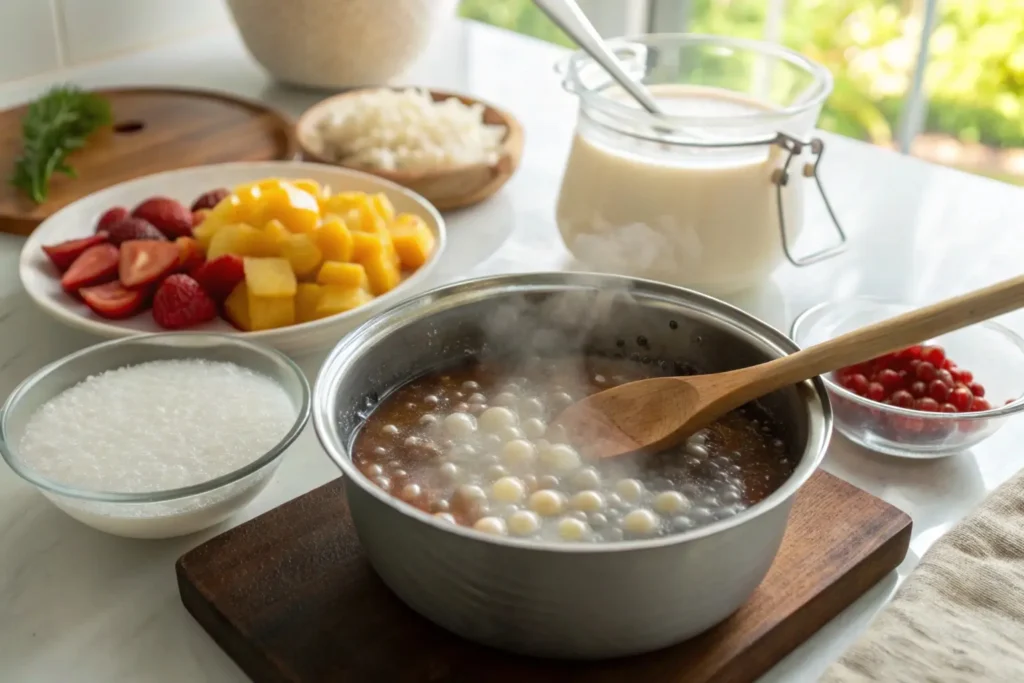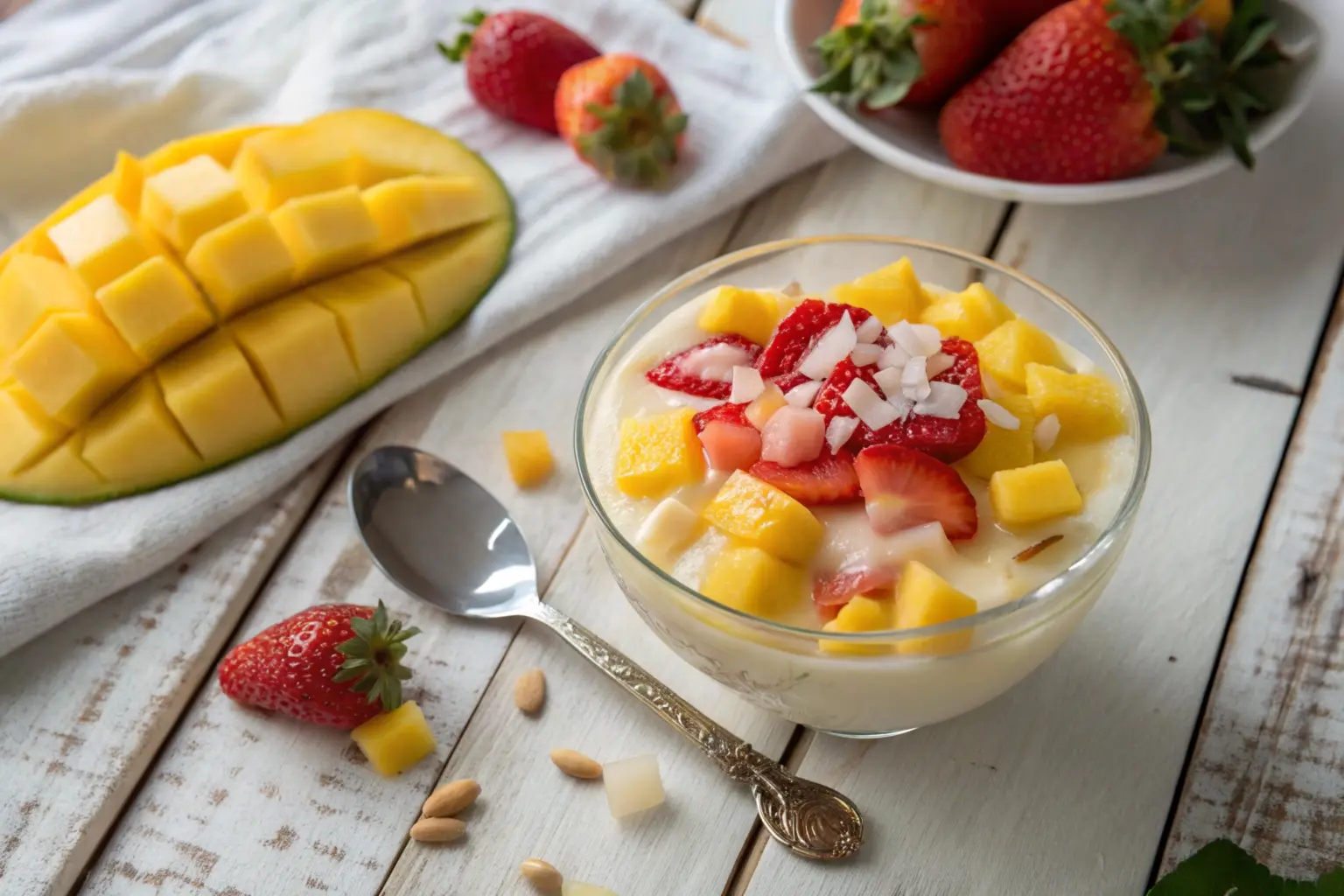If you’re looking for a dessert that’s both refreshing and indulgent, nata fruit pudding recipe is the perfect choice. This tropical-inspired treat combines the chewy goodness of nata de coco, the creaminess of coconut milk, and the natural sweetness of fresh fruits. Whether you’re hosting a summer party or craving something light yet satisfying, this recipe delivers a burst of flavor and texture in every spoonful.
In this article, we’ll walk you through everything you need to know—from the history of nata de coco to a step-by-step guide for creating this delicious dessert. Plus, we’ll share creative variations, nutritional benefits, and tips for perfecting your pudding. Let’s dive in!
Table of Contents
Introduction to Nata Fruit Pudding Recipe
What is Nata de Coco?
At the heart of a nata fruit pudding recipe lies nata de coco, a unique ingredient with a fascinating origin. Nata de coco is a chewy coconut jelly created through the fermentation of coconut water. This process uses a bacterial culture, Acetobacter xylinum, which transforms the sugars into cellulose. The result? A delightful, gelatinous treat that’s loved worldwide for its texture and versatility in desserts.
First popularized in the Philippines, nata de coco has become a staple in tropical desserts, drinks, and even ice creams. Its subtle sweetness and satisfying chewiness make it an ideal addition to the creamy pudding and fresh fruits in this recipe.
Why You’ll Love This Recipe
This nata fruit pudding recipe is a dessert for all occasions. Not only is it simple to prepare, but it’s also endlessly customizable. You can experiment with different fruits, adjust the sweetness to your liking, or even make it dairy-free. Plus, its light and refreshing qualities make it a crowd-pleaser for both kids and adults.
What sets this recipe apart is the harmonious blend of flavors and textures. The chewy nata de coco, silky pudding base, and vibrant fruits come together to create a dessert that’s as delightful to eat as it is to look at. Trust us—this will quickly become a favorite at your table.
Essential Ingredients for Nata Fruit Pudding Recipe
Core Ingredients for the Perfect Pudding
Creating a delicious nata fruit pudding recipe starts with selecting the right ingredients. Here’s what you’ll need:
- Nata de Coco: This chewy coconut jelly is the star of the show, adding a unique texture and mild sweetness to your pudding. Look for high-quality nata de coco in cans or jars, often available in Asian grocery stores.
- Fresh Fruits: Add a burst of natural flavor and color with fresh fruits like mangoes, strawberries, kiwis, or blueberries. These fruits not only enhance the taste but also make the pudding visually appealing.
- Coconut Milk or Cream: For the creamy base, use full-fat coconut milk or cream. It provides a rich and velvety texture, balancing the sweetness of the fruits and nata de coco.
- Sweetener: Adjust the sweetness to your preference with options like condensed milk, honey, or a low-calorie sugar substitute for a healthier twist.
- Tapioca Pearls: Optional but highly recommended, tapioca pearls bring another layer of texture to the pudding. Their chewy bite complements the nata de coco perfectly.
Substitutions for Dietary Needs
This recipe is versatile enough to accommodate various dietary preferences. For a dairy-free version, stick to coconut cream and use agave syrup or maple syrup as a sweetener. If you’re looking for a low-carb option, swap the tapioca pearls with chia seeds and use monk fruit sweetener instead of sugar. By making these small adjustments, your nata fruit pudding recipe can be tailored to suit any diet.
Step-by-Step Preparation Guide
Cooking Tapioca Pearls Perfectly

To prepare tapioca pearls for your pudding, start by boiling water in a medium saucepan. Add the pearls and stir continuously to prevent sticking. Cook them for about 10–15 minutes, or until they turn translucent. Remove from heat and let them sit in the hot water for another 10 minutes to ensure they’re fully cooked. Drain and rinse under cold water to stop the cooking process. This step ensures your pearls are perfectly chewy—a key element of the nata fruit pudding recipe.
Blending the Pudding Base
In a mixing bowl, combine coconut milk, sweetener, and a pinch of salt for balance. Whisk until smooth and well-mixed. If you prefer a thicker pudding, you can add cornstarch or gelatin dissolved in warm water. Heat the mixture on low heat, stirring constantly, until it thickens slightly. Let it cool to room temperature before layering it with the other ingredients.
Chilling and Serving Tips
For the best flavor and texture, refrigerate the pudding for at least 2–3 hours before serving. Chilling allows the flavors to meld together and ensures a refreshing experience. When ready to serve, layer the pudding in a glass bowl or individual cups, alternating with fresh fruits, nata de coco, and tapioca pearls. Top with a few extra fruits for a beautiful finish.
Creative Variations for Nata Fruit Pudding Recipe
Using Different Fruits for Unique Flavors
One of the best things about a nata fruit pudding recipe is its flexibility. You can use a wide variety of fruits to create unique flavor combinations. Mangoes and strawberries add tropical and tangy notes, while bananas provide a creamy texture. For a vibrant color palette, try adding kiwis, blueberries, or dragon fruit.
Seasonal fruits are another great way to customize your pudding. In the summer, opt for peaches or watermelon, and in the winter, incorporate pomegranate seeds for a festive touch. The possibilities are endless, allowing you to tailor the recipe to your taste and the occasion.
Adding Crunch or Layers for Texture
To elevate your pudding, consider incorporating crunchy elements. Crushed graham crackers, toasted coconut flakes, or even granola can add a delightful contrast to the creamy base. Layer these ingredients between the pudding and nata de coco for a parfait-style dessert that’s as appealing to the eye as it is to the palate.
Another creative variation is to add a jelly layer. Use fruit-flavored gelatin to create a clear, colorful topping that complements the pudding. This extra layer not only enhances the presentation but also introduces a fun, wobbly texture.
Dairy-Free and Vegan Options
For those following a vegan or dairy-free diet, this recipe is easy to adapt. Substitute regular condensed milk with coconut condensed milk or a plant-based alternative. Use agar-agar instead of gelatin for the jelly layer. These swaps ensure that everyone can enjoy this delicious dessert without compromising on flavor or texture.
Nutritional Benefits of Nata Fruit Pudding Recipe
Health Benefits of Coconut and Fruits
A nata fruit pudding recipe isn’t just delicious; it’s also packed with nutritional benefits. Coconut milk and nata de coco are rich in healthy fats and provide a quick energy boost. Meanwhile, the fresh fruits add essential vitamins, antioxidants, and fiber, supporting overall health and digestion.
This dessert is an excellent way to satisfy your sweet tooth while sneaking in a serving of fruit. Mangoes, for example, are high in vitamin C, while bananas provide potassium. Including a variety of fruits ensures a range of nutrients in every bite.
Low-Sugar and Gluten-Free Options
For those watching their sugar intake, this recipe can be easily modified. Opt for unsweetened coconut milk and use natural sweeteners like honey, stevia, or agave syrup. Additionally, replacing tapioca pearls with chia seeds is a great way to reduce carbohydrates and increase fiber content.
Since the base ingredients—coconut milk, nata de coco, and fruits—are naturally gluten-free, this dessert is also a safe choice for individuals with gluten sensitivities or celiac disease. With these adjustments, the nata fruit pudding recipe becomes a guilt-free treat that fits into many dietary plans.
FAQs About Nata Fruit Pudding Recipe
What Fruits Work Best in This Recipe?
One of the most frequently asked questions about the nata fruit pudding recipe is which fruits to use. The versatility of this dish allows for a wide range of options, ensuring that it can be tailored to suit your preferences or the fruits in season. Tropical fruits like mangoes, pineapples, and papayas are excellent choices for their sweetness and vibrant colors. Their juicy texture contrasts beautifully with the chewy nata de coco and creamy pudding base.
For a tart yet sweet balance, strawberries, raspberries, and blueberries are popular picks. These berries add a refreshing flavor that brightens the dessert. Bananas, on the other hand, bring a creamy and mellow sweetness that complements the pudding’s smooth texture. You could also experiment with more fascinating fruits like dragon fruit or lychees to make your nata fruit pudding recipe stand out at gatherings.
If you’re preparing this dish for a festive occasion, incorporating pomegranate seeds or mandarin orange slices can add a seasonal twist. These fruits not only enhance the taste but also elevate the dessert’s visual appeal.
How to Achieve the Best Chewy Texture for Tapioca Pearls?
Tapioca pearls are a key component in many variations of the nata fruit pudding recipe, but achieving the perfect chewy texture can require a bit of practice. Begin by boiling a large pot of water and adding the pearls while stirring to prevent them from clumping. Cook them for about 15 minutes or until they turn translucent, then let them sit in the hot water for another 10 minutes. This additional resting period ensures that the pearls are cooked evenly and remain soft and chewy.
Once cooked, rinse the pearls under cold water to halt the cooking process and maintain their texture. For an extra touch of flavor, soak the pearls in sweetened coconut milk or fruit juice before adding them to the pudding. This step allows the pearls to absorb additional flavor, creating a more cohesive and enjoyable dessert.
Can I Prepare This Recipe Ahead of Time?

Absolutely! One of the many benefits of the nata fruit pudding recipe is its convenience for advance preparation. Assemble the pudding layers in individual cups or a large serving dish, ensuring each layer is evenly distributed for a visually appealing presentation. Cover the dish tightly with plastic wrap to prevent the pudding from drying out in the fridge.
The assembled pudding can be stored in the refrigerator for up to two days, making it an ideal dessert for parties or busy schedules. However, it’s best to add the fresh fruit toppings just before serving to maintain their crispness and vibrant colors. This simple preparation strategy ensures your dessert is ready to impress with minimal last-minute effort.
By following these tips and answering common questions, you’ll master the art of creating a nata fruit pudding recipe that’s both convenient and crowd-pleasing.

